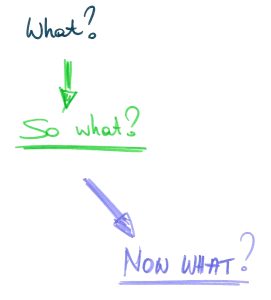This reflective model is probably amongst the simplest ones, as it is based on three questions only. However, this does not mean that the reflections should remain superficial, but should be as comprehensive as possible.
What ?
?
The first stage is a mere description of what happened and of the experience you would like to analyse and take forward for your own learning.
So what?
Once the description has been completed carefully you should ask yourself what the experience and situation means. To this end you will need to consult literature and colleagues if you are to get a comprehensive insight into the matter, as otherwise you will rely on your own interpretations only.
Now what?
At this last stage of Rolfe et al.’s model you are asked to consider the steps you will be taking in order to improve your practice and learn from the initial experience. You ought to complete a simple action plan with key pointers about what you will do and how you will decide that your practice has improved.
Reference:
Rolfe, G., Freshwater, D. and Jasper, M. (2001). Critical reflection in nursing and the helping professions: a user’s guide. Basingstoke: Palgrave Macmillan.
Rolfe et al.’s Reflective Model:
-What?
– I observed a student’s frustration during a statistics tutorial.
– So what?
– This highlighted the need to explore underlying causes, considering literature on student anxiety and learning.
– Now what?
– I plan to integrate more interactive and practical examples in tutorials to enhance understanding and reduce anxiety.
Brookfield’s Reflective Model:
– Autobiographical Lens:
– Reflecting on my own struggles with statistics may have influenced my response.
– Students’ Views:
– I need to engage students more actively to understand their challenges with statistics.
– Colleagues’ Views:
– Discussing with colleagues revealed alternative strategies to support students.
– Theoretical Lens:
– Applying educational psychology can help in designing effective teaching methods.
Gibbs’ Reflective Model:
– Description:
– A student’s frustration in a statistics tutorial was evident.
– Feelings:
– I felt concerned about the student’s progress and empathetic towards their struggle.
– Evaluation:
– It underscored the need for more interactive teaching methods.
– Analysis:
– Reviewing with peers provided insights into alternative approaches.
– Conclusions:
– Adapting teaching strategies is crucial for accommodating diverse learning needs.
– Action Plan:
– Integrate interactive activities and personalized support to enhance engagement and learning outcomes.
Tripp’s Critical Incidents:
– Critical Incident:
– Student struggles after lunchtime highlighted a need for reflection.
– Analysis and Response:
– Implementing short reading breaks post-lunch may improve student engagement.
Kolb’s Experiential Learning:
– Concrete Experience:
– Witnessing student frustration during a tutorial session.
– Reflective Observation:
– Identifying gaps in engaging students effectively.
– Abstract Conceptualization:
– Exploring teaching methodologies to integrate practical examples.
– Active Experimentation:
– Testing interactive teaching methods to enhance comprehension and engagement.